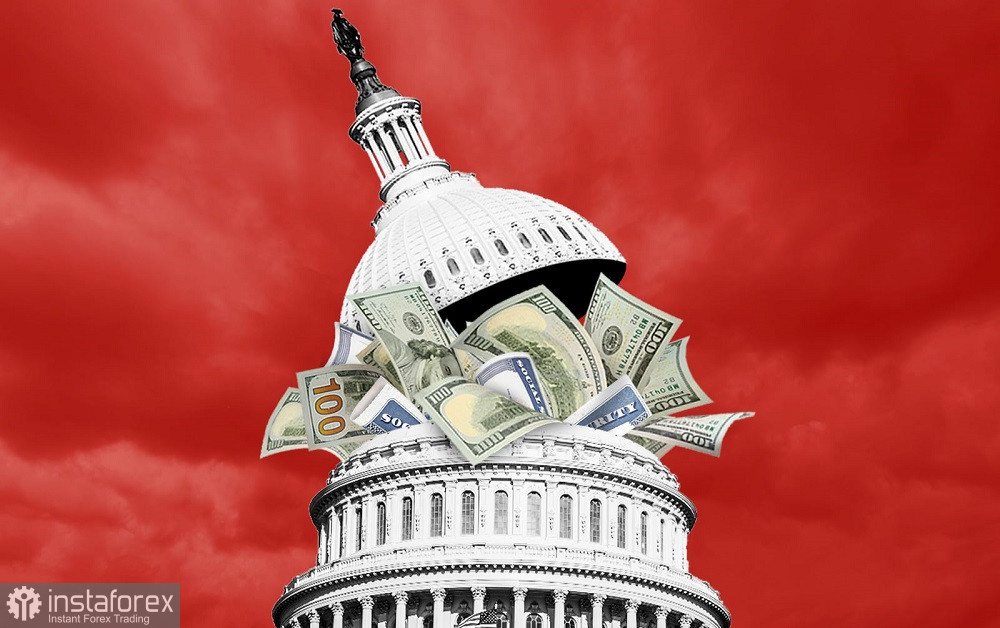The situation with the U.S. government debt is gaining influence over traders with each passing day. It's not surprising, as the deadline set by the U.S. Treasury Department (June 1) is getting closer, and the parties are still far from reaching a deal.

Furthermore, it was announced today that the House of Representatives is going on planned recess. Although the majority leader in the lower house assured journalists that congressmen would return promptly from their vacations to approve a (possible) deal on raising the debt ceiling, market participants reacted painfully to this news. The U.S. dollar index reached a 9-week high today, returning to the 104 level for the first time since March. The major dollar pairs adjusted accordingly, with the EUR/USD pair plummeting to the 1.07 level, marking a two-month price low.
Market Ignores Fed Minutes
It is noteworthy that the dollar bulls are completely disregarding the dovish signals recently coming from the Fed. The hawkish messages that were voiced at the beginning of May have been replaced by softer comments, especially after another troubled U.S. bank, PacWest, reminded everyone of its existence.
First and foremost, it is necessary to recall Jerome Powell's resonant speech that took place last week. The head of the Federal Reserve focused his attention on the banking crisis, linking recent events in this sector to the aggressive policies of the U.S. regulator. According to him, the recent banking stress has reduced the need for an interest rate hike. He also noted that the Federal Reserve can afford to assess the effectiveness of the measures taken "to draw conclusions about the future prospects of monetary policy."
The minutes of the May meeting of the Federal Reserve, published yesterday, also had a dovish tone. The document stated that the committee members generally agreed that the need for further interest rate hikes has become "less certain." Additionally, some Fed officials noted that the approved 25 basis point increase "may be the last in the current cycle of tightening monetary policy." In their opinion, if the U.S. economy moves in line with forecasts, further rate hikes (after the May meeting) may not be necessary.
However, "some" committee members cautioned that the Federal Reserve should remain open to the possible implementation of a hawkish scenario, considering the risks of persistent inflation, which "still exceeds the Fed's target of two percent by more than twice."
According to the CME FedWatch Tool, the probability of maintaining the status quo at the June meeting is currently 65%. Powell's dovish comments (along with those of some of his colleagues) and the dovish rhetoric in the Fed minutes have had an impact: hawkish expectations regarding the future actions of the U.S. regulator have significantly diminished.
However, dollar pair traders are completely disregarding this fact.
The Clock Is Ticking
There is very little time left until June 1, just one week, and Republicans and Democrats have still not reached an agreement on raising the debt ceiling. The "specter of default" is comparable to a real ghost: few believe in it, but many are afraid. For example, according to JPMorgan experts, the probability of a U.S. default currently stands at approximately 25%, "but this probability gradually increases with each passing day."
Meanwhile, Fitch Ratings has placed the credit rating of the United States under review with a potential downgrade. Representatives of the agency have stated that they may lower the country's rating (currently at the highest level, AAA) if Congress does not raise or suspend the limit on the national debt. The statement also indicates that the risks of the debt limit not being raised have increased. The seriousness of the situation is highlighted by the fact that Fitch last placed the U.S. rating under review almost 10 years ago, in October 2013. However, back then, there was no downgrade.
Whether the most negative scenario will be realized this year remains an open question. Considering the catastrophic consequences of a default, most economists are confident that the parties will eventually find common ground through active political negotiations. Moreover, both Republicans and Democrats express optimism, citing productive talks and ruling out the possibility of a default. But as they say, the clock is ticking, and the sword of Damocles hangs overhead. The closer we get to June 1, the more nervous market participants become. Meanwhile, the safe-haven dollar takes advantage, benefiting from the rise in risk-off sentiment.
Conclusion
The main risk in this situation is that, at some point, Republicans and Democrats will indeed come to a compromise. There is no doubt about that. When it will happen, whether today or in the final hours of May 31, remains uncertain. But the much-anticipated happy ending will come unexpectedly, after which the coiled spring will recoil, this time against the greenback. In that case, classic fundamental factors that are mostly unfavorable for the U.S. currency will return to the forefront.
Therefore, despite the attractiveness of selling, short positions on the EUR/USD pair are still risky. The risk of hitting a "price bottom" is very high.
 English
English 
 Русский
Русский Bahasa Indonesia
Bahasa Indonesia Bahasa Malay
Bahasa Malay ไทย
ไทย Español
Español Deutsch
Deutsch Български
Български Français
Français Tiếng Việt
Tiếng Việt 中文
中文 বাংলা
বাংলা हिन्दी
हिन्दी Čeština
Čeština Українська
Українська Română
Română

